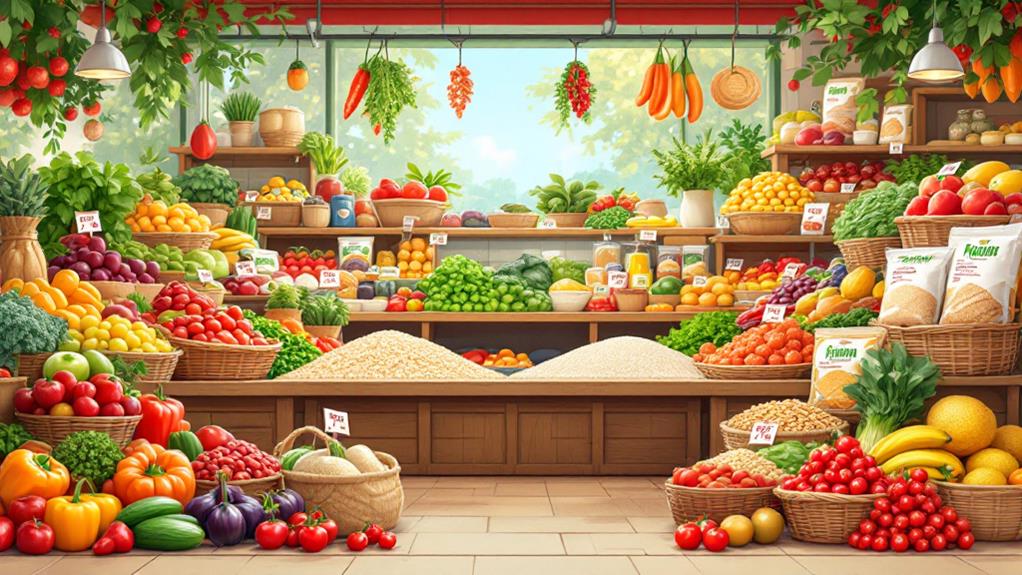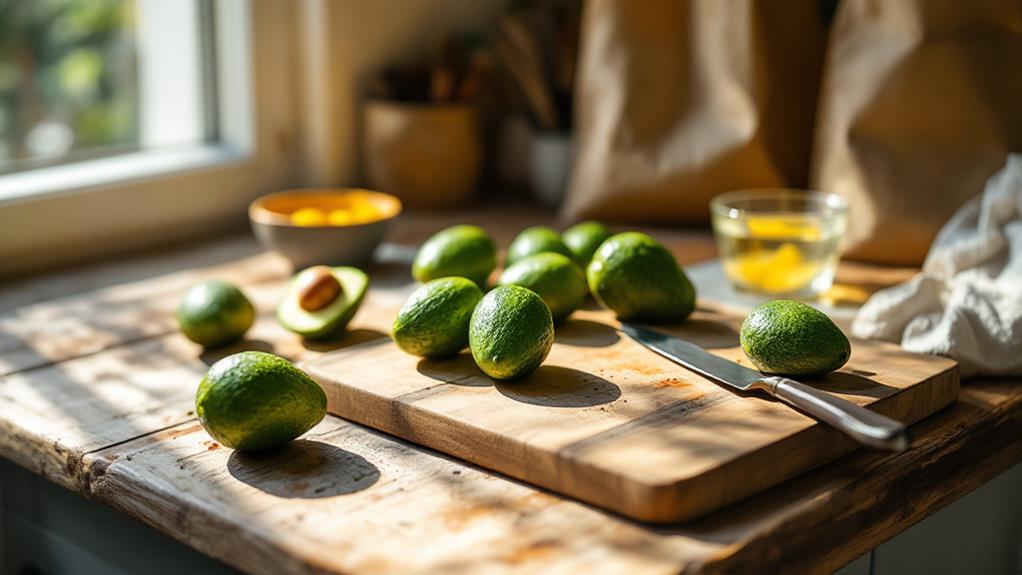Is Eating Organic on a Tight Budget Possible? Tips for Affordable Organic Shopping
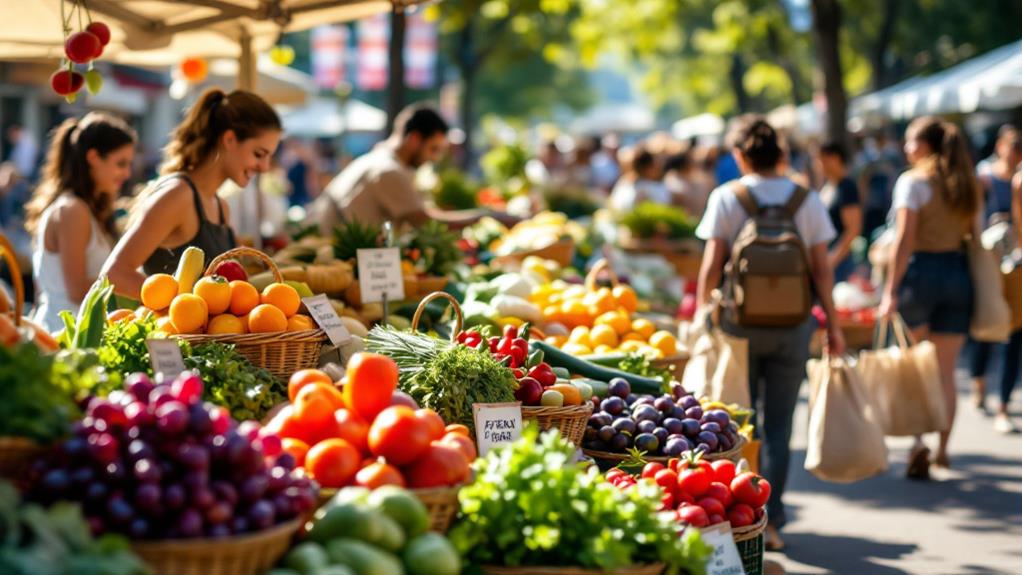
Absolutely, you can eat organic on a tight budget by being smart and resourceful. Start by focusing on high-pesticide produce from the Dirty Dozen list to prioritize your organic purchases. Utilize discounts using apps and loyalty programs, and get involved with community-supported agriculture for fresh, organic produce at great prices. Shop seasonally and locally to find the best deals, and cook from scratch to make your budget stretch further. Buy in bulk and consider starting a small home garden with organic seeds. These strategies can help you enjoy organic foods without breaking the bank, offering plenty of creative approaches.
Prioritizing High-Pesticide Produce
Regarding managing your grocery budget, prioritizing high-pesticide produce for organic purchases makes a lot of sense. The Environmental Working Group's Dirty Dozen list is your go-to guide for identifying which produce you should buy organic. For 2023, strawberries, spinach, and kale top this list due to their high pesticide residues. By opting for organic versions of these items, you greatly reduce your exposure to synthetic pesticides, which are prohibited in organic farming practices.
Choosing organic produce, especially from the Dirty Dozen, directly impacts your health outcomes. Studies show that lowering pesticide exposure through organic choices can reduce the risk of chronic diseases. Therefore, focusing your budget on these high-pesticide items can lead to better health, making it an affordable organic strategy despite the often higher cost of organic goods.
While organic versions of the Dirty Dozen should be your priority, you can save on other produce. The EWG's Clean Fifteen list features items like avocados and sweet corn, which have low pesticide residues even when conventionally grown. This lets you allocate more of your budget to crucial organic purchases, ensuring you're making the most impactful decisions for your health and finances.
Leveraging Coupons and Discounts
While focusing on organic versions of high-pesticide produce like strawberries and spinach can greatly benefit your health, managing the higher costs remains a concern. You can definitely save money by leveraging different coupons and discounts available for organic products. Here's how:
- Coupons and Cash Back Apps: Utilize websites like Coupons.com and SmartSource to find and print discounts on organic products. Furthermore, apps like Ibotta and Fetch Rewards offer cash back options on organic items, letting you save more without linking your checking account.
- Store Loyalty Programs: Many supermarkets have loyalty programs that offer exclusive discounts on organic products. Joining these programs can lead to significant savings over time. Keep an eye out for special promotions and digital coupons tailored specifically for organic items.
- Bulk Purchase Discounts: Stores like Whole Foods often provide bulk purchase discounts, such as 10% off when you buy cases of products like yogurt. By buying in larger quantities, you can save more in the long run.
Don't forget to sign up for newsletters from your favorite organic brands or stores. They often share information about upcoming sales and exclusive promotions, helping you stay ahead in the savings game.
Embracing Seasonal Shopping

Seasonal shopping offers a practical way to cut costs while enjoying the freshest produce available. By focusing on seasonal produce, you often find lower prices because these items need less transportation and support local farmers, which also helps reduce your carbon footprint. Buying what's in season means you're getting fresher, more flavorful, and nutritionally packed fruits and vegetables compared to their out-of-season counterparts that may have been stored for longer periods.
Engaging with local farmers through community-supported agriculture (CSA) programs is a fantastic way to access organic options at competitive prices. These programs allow you to receive a share of the harvest, giving you a variety of seasonal produce directly from the source. It's a win-win situation: you support local agriculture, and you save money.
Integrating seasonal shopping into your routine can also inspire creativity in meal planning. With an abundance of in-season fruits and vegetables, you can investigate new recipes and enjoy diverse meals. Planning your meals around these available items not only boosts your culinary experience but also leads to significant savings, as these products are often discounted during peak harvest times. Welcome the season, and your wallet will thank you.
Exploring Local Markets
Uncover countless gems at local farmers' markets, where you can find organic produce at competitive prices. Supporting local agriculture at these markets not only saves you money but also guarantees you get the freshest seasonal produce available. By purchasing directly from farmers, you avoid middlemen, which means more of your money goes to those who grow your food, promoting sustainable practices.
Many markets showcase a variety of seasonal produce, which is typically fresher and more affordable than out-of-season items. This is because seasonal goods have lower transportation costs and are often harvested at their peak ripeness. Furthermore, community-supported agriculture (CSA) programs are a fantastic way to secure a steady supply of organic produce. By subscribing, you receive a weekly share of local produce, often at a reduced cost, making it a budget-friendly option for consistent access to healthy foods.
Consider u-pick opportunities at nearby farms as well. Harvesting your own fruits and vegetables can greatly cut down costs and offer a delightful day out. Here are three tips to improve your experience:
- Plan your visit to coincide with peak harvest times.
- Bring your own containers to transport your produce.
- Ask farmers for tips on selecting the best produce.
Cooking From Scratch
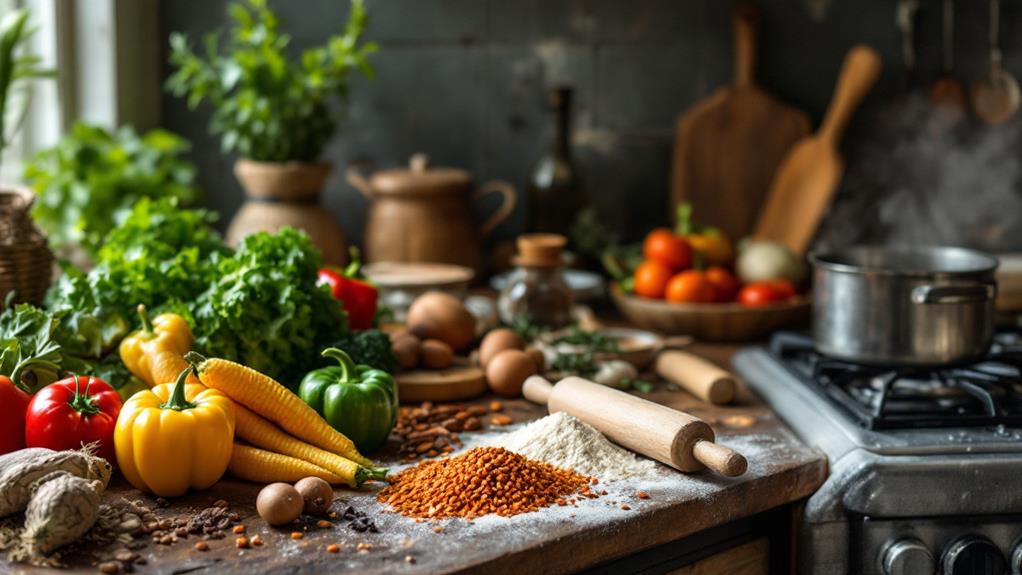
Cooking from scratch builds on the benefits of sourcing fresh, organic ingredients from local markets. By taking control of what goes into your meals, you can make the most of affordable organic staples like grains and legumes, which can greatly reduce your grocery bill. Creating homemade versions of everyday items, such as salad dressings or yogurt, not only guarantees you're using organic ingredients but also keeps costs down compared to store-bought options.
Simple recipes with minimal ingredients are your best friend when trying to keep food expenses low while still enjoying nutritious meals. Plus, batch cooking is a game-changer. It saves you time and money by utilizing seasonal produce and taking advantage of bulk pricing. Cooking in larger quantities means you'll have meals ready for those busy days, and you're less likely to resort to expensive takeout.
Don't forget about leftovers—these are a goldmine for reducing food waste and stretching your budget. Transform yesterday's dinner into today's lunch or incorporate it into a new dish. By doing so, you're maximizing every ingredient's potential and embracing a more sustainable, cost-effective approach to eating organic.
Reducing Packaged Foods
Reducing your reliance on packaged foods is a smart move both for your wallet and your health. Packaged organic foods often carry a higher price tag, enhancing your grocery bills unnecessarily. Instead, focusing on whole foods can lead to healthier meals and more cost-effective shopping. Here's how you can make the change:
- Embrace Whole Foods: Prioritize organic foods in their natural form. Fresh produce, grains, and meats not only offer better nutrition but also save you money compared to their packaged organic counterparts.
- Create Homemade Alternatives: Invest time in making your own meals and snacks. Homemade granola, soups, or bread often taste better and are more affordable. Plus, you control the ingredients, ensuring they're healthier and organic.
- Plan for Bulk Buying: Shifting to bulk buying for staples like grains, beans, and dried fruits can greatly reduce costs and minimize packaging waste. This way, you'll have a pantry stocked with necessities ready for homemade creations.
Bulk Buying Strategies
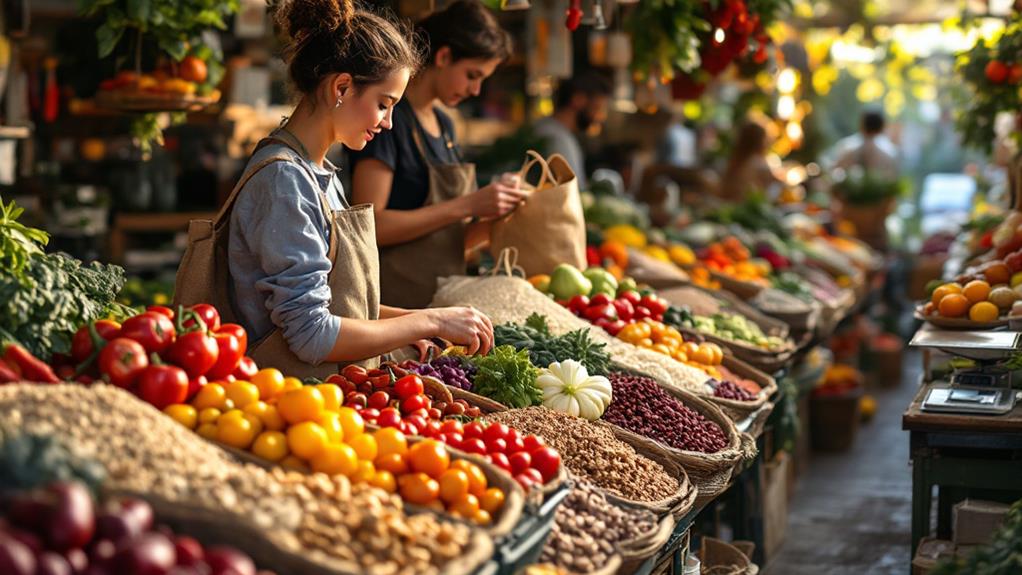
After you've welcomed whole foods and started creating homemade alternatives, it's time to investigate bulk buying strategies to enhance your organic shopping experience. Buying in bulk can considerably lower your grocery bill, especially for long-lasting staples like grains, beans, and frozen produce. These items often come at reduced prices when purchased in larger quantities, making them ideal for budget-conscious shoppers. Many grocery stores, including Whole Foods, offer discounts on bulk purchases—like 10% off cases of yogurt—encouraging you to stock up on necessary items.
Consider exploring membership warehouse clubs like Costco, where you can find organic products at a fraction of regular grocery store prices. A 3-pack of organic milk, for example, might cost about $11, offering considerable savings. Opting for bulk bins at stores is another smart strategy. Not only do they reduce packaging waste, but they also let you buy exactly the amount you need, preventing over-purchasing and food waste.
Home Gardening Basics
Starting a home garden is an excellent way to enjoy fresh organic produce without breaking the bank. By growing your own vegetables, you can guarantee that what you eat adheres to organic standards while saving money. Here's how you can start your own garden:
- Choose the Right Seeds: Opt for certified organic seeds from local garden centers. These seeds assure quality and sustainability, giving you a productive and eco-friendly harvest.
- Utilize Small Spaces: Even if you're short on space, container gardening can work wonders. Tomatoes, peppers, and herbs thrive in pots or other small spaces. Raised beds can also improve soil quality and drainage, making it easier to manage your garden and promote growth.
- Maintain Regularly: Keep your garden healthy with practices like crop rotation and companion planting. These methods not only elevate soil health and reduce pests but also lead to a more bountiful harvest.
While engaging with community gardening initiatives can offer supplementary resources and support, focusing on your home gardening setup provides a solid foundation for growing organic produce. Remember, you can enjoy organic on a budget without needing expansive land or resources. Happy gardening!
Engaging Community Resources

Many people find that engaging community resources can greatly improve their access to affordable organic produce. By joining community-supported agriculture (CSA) programs, you receive a share of seasonal organic produce at a lower cost. This approach not only supports local farmers but also promotes sustainable agriculture. Furthermore, participating in local food co-ops can be a game-changer. These co-ops often provide access to bulk organic items at discounted prices, encouraging collaboration and shared resources for more affordable shopping.
Community gardening initiatives are another fantastic way to engage with others while growing your organic produce. These initiatives allow you to share knowledge and resources, reducing the cost burden of gardening alone. Plus, they foster a sense of community, which is invaluable.
Consider organizing produce swaps with your neighbors. This can diversify your diet and let you enjoy a greater variety of organic foods without the financial strain of buying everything at retail prices. To find these opportunities, use social media or local bulletin boards to connect with local farmers or gardening groups. These platforms are excellent for finding organic deals, exchanges, and community events focused on sustainable living.

